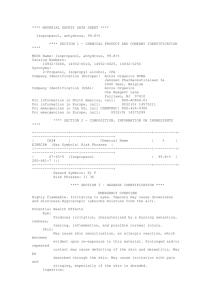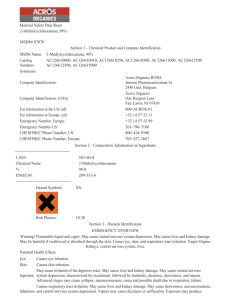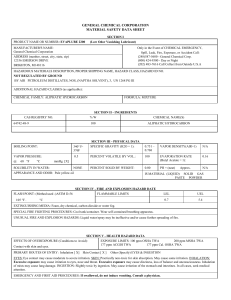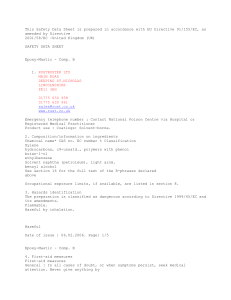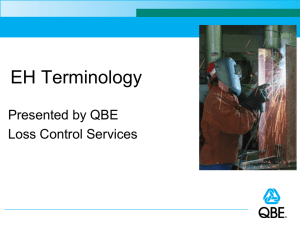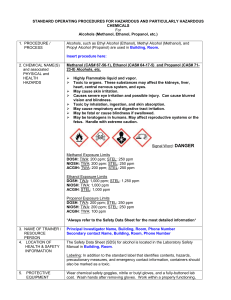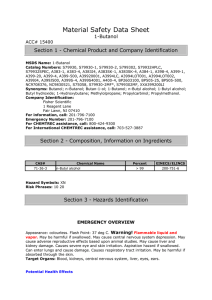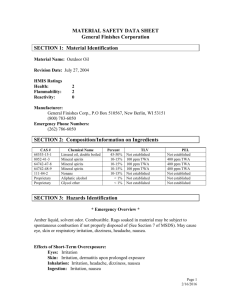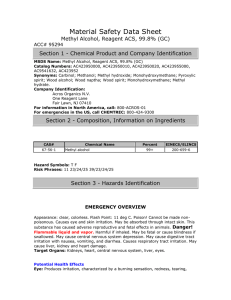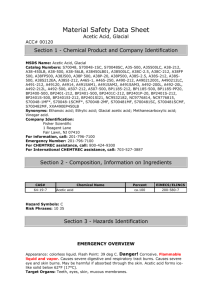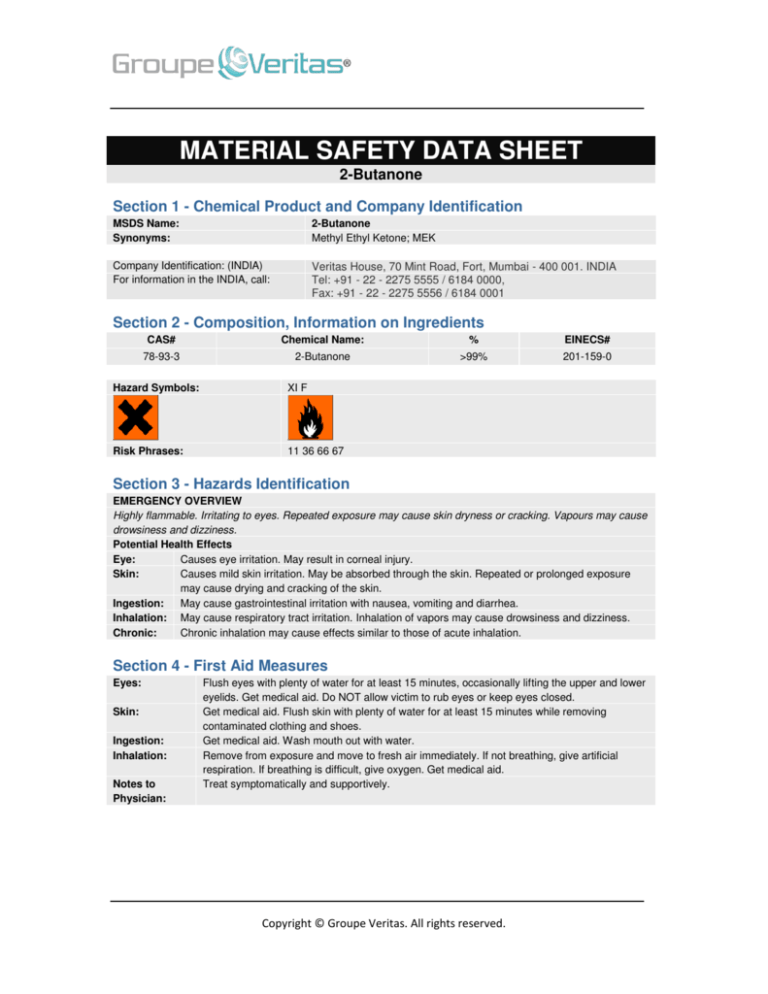
MATERIAL SAFETY DATA SHEET
2-Butanone
Section 1 - Chemical Product and Company Identification
MSDS Name:
Synonyms:
2-Butanone
Methyl Ethyl Ketone; MEK
Company Identification: (INDIA)
For information in the INDIA, call:
Veritas House, 70 Mint Road, Fort, Mumbai - 400 001. INDIA
Tel: +91 - 22 - 2275 5555 / 6184 0000,
Fax: +91 - 22 - 2275 5556 / 6184 0001
Section 2 - Composition, Information on Ingredients
CAS#
Chemical Name:
%
EINECS#
78-93-3
2-Butanone
>99%
201-159-0
Hazard Symbols:
XI F
Risk Phrases:
11 36 66 67
Section 3 - Hazards Identification
EMERGENCY OVERVIEW
Highly flammable. Irritating to eyes. Repeated exposure may cause skin dryness or cracking. Vapours may cause
drowsiness and dizziness.
Potential Health Effects
Eye:
Causes eye irritation. May result in corneal injury.
Skin:
Causes mild skin irritation. May be absorbed through the skin. Repeated or prolonged exposure
may cause drying and cracking of the skin.
Ingestion:
May cause gastrointestinal irritation with nausea, vomiting and diarrhea.
Inhalation: May cause respiratory tract irritation. Inhalation of vapors may cause drowsiness and dizziness.
Chronic:
Chronic inhalation may cause effects similar to those of acute inhalation.
Section 4 - First Aid Measures
Eyes:
Skin:
Ingestion:
Inhalation:
Notes to
Physician:
Flush eyes with plenty of water for at least 15 minutes, occasionally lifting the upper and lower
eyelids. Get medical aid. Do NOT allow victim to rub eyes or keep eyes closed.
Get medical aid. Flush skin with plenty of water for at least 15 minutes while removing
contaminated clothing and shoes.
Get medical aid. Wash mouth out with water.
Remove from exposure and move to fresh air immediately. If not breathing, give artificial
respiration. If breathing is difficult, give oxygen. Get medical aid.
Treat symptomatically and supportively.
Copyright © Groupe Veritas. All rights reserved.
Section 5 - Fire Fighting Measures
General
Information:
Extinguishing
Media:
As in any fire, wear a self-contained breathing apparatus in pressure-demand, MSHA/NIOSH
(approved or equivalent), and full protective gear. Vapors can travel to a source of ignition
and flash back. Will burn if involved in a fire. Flammable liquid and vapor.
Use water spray, dry chemical, carbon dioxide, or chemical foam.
Section 6 - Accidental Release Measures
General
Information:
Spills/Leaks:
Use proper personal protective equipment as indicated in Section 8.
Absorb spill with inert material (e.g. vermiculite, sand or earth), then place in suitable container.
Avoid runoff into storm sewers and ditches which lead to waterways. Wear a self contained
breathing apparatus and appropriate personal protection. (See Exposure Controls, Personal
Protection section). Remove all sources of ignition. Use a spark-proof tool. Do not let this
chemical enter the environment.
Section 7 - Handling and Storage
Handling:
Storage:
Use spark-proof tools and explosion proof equipment. Avoid breathing dust, vapor, mist, or
gas. Avoid contact with skin and eyes. Take precautionary measures against static discharges.
Avoid ingestion and inhalation.
Keep away from sources of ignition. Store in a cool, dry place. Store in a tightly closed
container. Flammables-area.
Section 8 - Exposure Controls, Personal Protection
Engineering Controls:
Facilities storing or utilizing this material should be equipped with an eyewash facility and a
safety shower. Use adequate general or local exhaust ventilation to keep airborne
concentrations below the permissible exposure limits.
Exposure Limits
CAS# 78-93-3:
United Kingdom, WEL - TWA: 200 ppm TWA; 600 mg/m3 TWA United Kingdom, WEL STEL: 300 ppm STEL; 899 mg/m3 STEL
United States OSHA: 200 ppm TWA; 590 mg/m3 TWA
Belgium - TWA: 200 ppm VLE; 600 mg/m3 VLE Belgium - STEL: 300 ppm VLE; 900 mg/m3
VLE
France - VME: 200 ppm VME; 600 mg/m3 VME France - VLE: 300 ppm VLE; 900 mg/m3
VLE
Germany: 200 ppm TWA; 600 mg/m3 TWA Germany: skin notation
Japan: 200 ppm OEL; 590 mg/m3 OEL
Malaysia: 200 ppm TWA; 590 mg/m3 TWA
Netherlands: 200 ppm MAC; 590 mg/m3 MAC
Russia: 200 mg/m3 TWA (vapour)
Spain: 200 ppm VLA-ED; 600 mg/m3 VLA-ED Spain: 300 ppm VLA-EC; 900 mg/m3 VLAEC
Personal Protective Equipment
Eyes:
Wear chemical splash goggles.
Skin:
Wear appropriate protective gloves to prevent skin exposure.
Clothing:
Wear appropriate protective clothing to prevent skin exposure.
Copyright © Groupe Veritas. All rights reserved.
Respirators:
Follow the OSHA respirator regulations found in 29 CFR 1910.134 or European Standard EN
149. Use a NIOSH/MSHA or European Standard EN 149 approved respirator if exposure
limits are exceeded or if irritation or other symptoms are experienced.
Section 9 - Physical and Chemical Properties
Physical State:
Clear liquid
Color:
colorless
Odor:
sweetish odor - characteristic odor
pH:
Not available
Vapor Pressure:
105mbar @20 deg C
Viscosity:
0.42 mPa s @15 deg C
Boiling Point:
80 deg C @760mmHg ( 176.00°F)
Freezing/Melting Point:
-87 deg C ( -124.60°F)
Autoignition Temperature:
404 deg C ( 759.20 deg F)
Flash Point:
-7 deg C ( 19.40 deg F)
Explosion Limits: Lower:
1.8 Vol %
Explosion Limits: Upper:
11.5 Vol %
Decomposition Temperature:
Not available
Solubility in water:
290 g/l (20°C)
Specific Gravity/Density:
0.806
Molecular Formula:
C4H8O
Molecular Weight:
72.11
Section 10 - Stability and Reactivity
Chemical Stability:
Conditions to Avoid:
Incompatibilities with Other
Materials
Hazardous Decomposition
Products
Hazardous Polymerization
Stable under normal temperatures and pressures.
Incompatible materials, ignition sources, excess heat.
Oxidizing agents, ammonia, copper, nitric acid, sulfuric acid, isocyanates,
hydrogen peroxide, amines (aliphatic and aromatic, e.g. dimethylamine,
propylamine, pyridine, triethylamine), caustics (e.g. ammonia, ammonium
hydroxide, calcium hydroxide, potassium hydroxide, sodium hydroxide),
chlorosulfonic acid.
Carbon monoxide, carbon dioxide.
Will not occur.
Section 11 - Toxicological Information
RTECS#:
LD50/LC50:
Carcinogenicity:
CAS# 78-93-3: EL6475000
RTECS:
CAS# 78-93-3: Draize test, rabbit, eye: 80 mg;
Draize test, rabbit, skin: 500 mg/24H Moderate;
Draize test, rabbit, skin: 402 mg/24H Mild;
Inhalation, mouse: LC50 = 32 gm/m3/4H;
Inhalation, rat: LC50 = 23500 mg/m3/8H;
Oral, mouse: LD50 = 3000 mg/kg;
Oral, rat: LD50 = 2737 mg/kg;
Skin, rabbit: LD50 = 6480 mg/kg;
2-Butanone - Not listed as a carcinogen by ACGIH, IARC, NTP, or CA Prop
Copyright © Groupe Veritas. All rights reserved.
65.
See actual entry in RTECS for complete information. Mutagenicity: Amestest: negative.
Other:
Section 12 - Ecological Information
Ecotoxicity:
Other:
Daphnia: Daphnia: EC50: 5091 mg/L; 7 days; Fish: Fathead Minnow: LC50: 3220 mg/L; 48h; .
Bacteria: Pseudomonas putida: EC50: 1150 mg/L; 16h;
Do not empty into drains. Readily biodegradable. Log POW: 0.29 (exp.)
Section 13 - Disposal Considerations
Dispose of in a manner consistent with federal, state, and local regulations
Section 14 - Transport Information
Shipping Name:
IATA
ETHYL METHYL KETONE
IMO
ETHYL METHYL KETONE
RID/ADR
ETHYL METHYL KETONE
Hazard Class:
UN Number:
Packing Group:
3
1193
II
3
1193
II
3
1193
II
USA RQ: CAS# 78-93-3: 5000 lb final RQ; 2270 kg final RQ
Section 15 - Regulatory Information
European/International Regulations
European Labeling in Accordance with EC Directives
Hazard Symbols: XI F
Risk Phrases:
R 11 Highly flammable.
R 36 Irritating to eyes.
R 66 Repeated exposure may cause skin dryness or cracking.
R 67 Vapours may cause drowsiness and dizziness.
Safety Phrases:
S 9 Keep container in a well-ventilated place.
S 16 Keep away from sources of ignition - No smoking.
WGK (Water Danger/Protection)
CAS# 78-93-3: 1
Canada
CAS# 78-93-3 is listed on Canada's DSL List
US Federal
TSCA
CAS# 78-93-3 is listed on the TSCA Inventory.
Section 16 - Other Information
MSDS Creation Date:
July 22, 2015
Revision #0 Date
Copyright © Groupe Veritas. All rights reserved.
The information above is believed to be accurate and represents the best information currently available to us. However, we
make no warranty of merchantibility or any other warranty, express or implied, with respect to such information, and we assume
no liability resulting from its use. Users should make their own investigations to determine the suitability of the information for
their particular purposes. In no event shall the company be liable for any claims, losses, or damages of any third party or for lost
profits or any special, indirect, incidental, consequential, or exemplary damages howsoever arising, even if the company has
been advised of the possibility of such damages.
Copyright © Groupe Veritas. All rights reserved.

